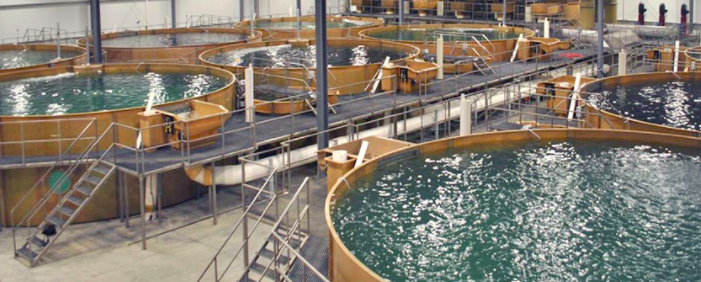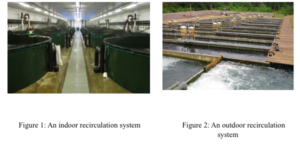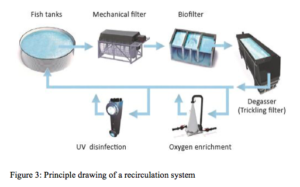
This article gives a vivid explanation about the recent advances in agriculture more specifically in fishery sector. Now we are talking about sustainability of resources, so in this regard this article proves to be beneficial to spread awareness on RAS (Recirculating Aquaculture Systems). This article explains how in limited space and resources we can do aquaculture.
Priyanka Lal1*, Binita Kumari1, Tulika Kumari1, Priyanka Singh2 1Research Scholar, ICAR-NDRI, Karnal 2Research Scholar, Punjab Agricultural University, Ludhiana *Email of corresponding author: priyanka.lal6@gmail.com
Introduction
Recirculating aquaculture systems (RAS) are systems in which aquatic organisms are cultured in water which is serially reconditioned and reused. Recirculating aquaculture systems are indoor, tank based systems in which fish are grown at high density under controlled environmental conditions. Generally, farmers adopt a more intensive approach (higher densities and more rigorous management) than other aquaculture production systems. Recirculating aquaculture systems can be used where suitable land or water is limited, or where environmental conditions are not ideal for the species being cultured. This type of aquaculture production system can be used in marine environments; however, it is more commonly used in freshwater environments. Recirculating aquaculture systems are very much useful for maintaining the sustainability of the environment specially when in future there will be scarcity of all the resources. The technology is based on the use of mechanical and biological filters, and the method can in principle be used for any species grown in aquaculture such as fish, shrimps, clams, etc. Recirculation technology is however primarily used in fish farming. Recirculation is growing rapidly in many areas of the fish farming sector, and systems are deployed in production units that vary from huge plants generating many tonnes of fish per year for consumption to small sophisticated systems used for restocking or to save endangered species.
Production Considerations
• Fish Species Selection
• Feeds and Feeding
• Warm Temperature
• Legal Restrictions
• Market Opportunities
• Financing

Why Recirculate?
• Conserves water
• Permits high density culture in locations where space and or water are limiting
• Minimizes volume of effluent, facilitating waste recovery
• Allows for increased control over the culture environment, especially indoors
• Improved biosecurity
• Environmentally sustainable
• The nutrients from the farmed fish can be used as fertilizer on agricultural farming land or as a basis for biogas production.
The Ras Design
The functional parts of a RAS include a:
(1) growing tank,
(2) sump of particulate removal device,
(3) biofilter,
(4) oxygen injection with U-tube aeration and,
(5) water circulation pump.
Depending on the water temperature and fish species selected, a water heating system may be necessary. Ozone and ultraviolet sterilization also may be advantageous to reduce organic and bacteria loads.
Figure 3: Principle drawing of a recirculation system

Special types of RAS
Aquaponics
Combining plants and fish in a RAS is referred to as aquaponics. In this type of system ammonia produced by the fish is not only converted to nitrate but is also removed by the plants from the water. In an aquaponics system fish effectively fertilize the plants, this creates a closed looped system where very little waste is generated and inputs are minimized. Aquaponics provides the advantage of being able to harvest and sell multiple crops.
Aquariums
Home aquaria and inland commercial aquariums are a form of RAS where the water quality is very carefully controlled and the stocking density of fish is relatively low. In these systems the goal is to display the fish rather than producing food. However, biofilters and other forms of water treatment are still used to reduce the need to exchange water and to maintain water clarity. Just like in traditional RAS water must be removed periodically to prevent nitrate and other toxic chemicals from building up in the system. Coastal aquariums often have high rates of water exchange and are typically not operated as a RAS due to their proximity to a large body of clean water.
Disadvantages
• High upfront investment in materials and infrastructure.
• High operating costs mostly due to electricity, and system maintenance.
• A need for highly trained staff to monitor and operate the system.
Conclusions
With the advent of many new technologies, our resources are continuously depleting. So there was need for sustainability of resources. There is need of technology which is both environment friendly as well as sustainable in nature thus giving more output using less resources. RAS is such type of technology which should be made popular among farmers. Recirculating aquaculture systems are very much useful for maintaining the sustainability of the environment specially when in future there will be scarcity of all the resources.
hello, I’m a computer engineer want to know to more about RAS..I want to start this
What is the total cost of setting up this system pleasde
I have been working on the project management role with the team.